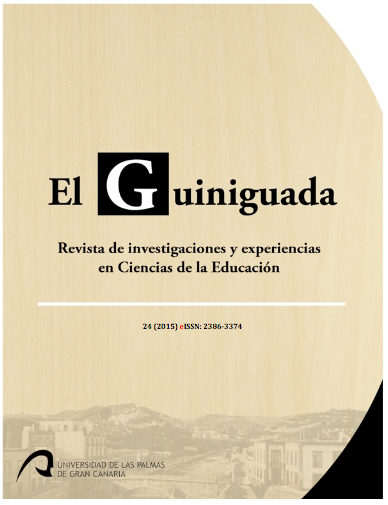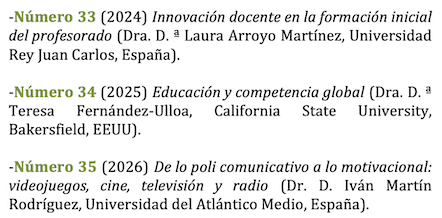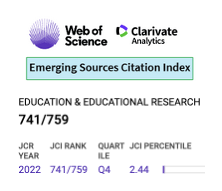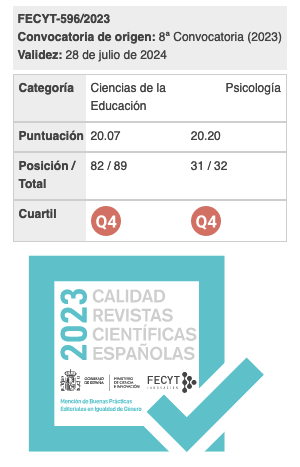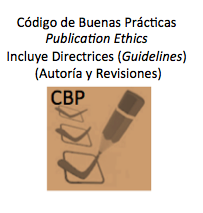CLIL Materials in Secondary Education: focusing on the Language of instruction in the subject area of Mathematics. doi 10.20420/GUIN.2015.0076
Palabras clave:
CLIL, Language of Instruction, English, Maths, Secondary Education.Resumen
Applying a CLIL methodological approach marks a shift in emphasis from language learning based on linguistic form and grammatical progression to a more ‘language acquisition’ one which takes account language functions. In this article we will study the elements of the “language of instruction” of the area of Maths in Secondary Education, by focusing on the analysis of the communicative functions, and the lexical and the cultural items present in the textbook in use. Our aim is to present the CLIL teacher with the linguistic and didactic implications that he or she should take into consideration when implementing the bilingual syllabuses with their students. In order to do that, we will present our conclusions emphasizing the need for coordination in different content areas, linguistic and communicative contents, between the foreign language teacher and the CLIL subject one.
DOI 10.20420/GUIN.2015.0076
Descargas
Citas
Dale, L. & Tanner, R. (2012). CLIL Activities: a Resource for Subject and Language Teachers. Cambridge: Cambridge University Press.
Dalton-Puffer, C. (2007). Discourse in Content and Language Integrated Learning (CLIL) Classrooms. Amsterdam: John Benjamins Pub.
Dalton-Puffer, C. (2009). Communicative Competence and the CLIL Lesson. In Ruiz de Zarobe & Jiménez Catalán (eds.), Content and Language Integrated Learning: Evidence from Research in Europe (197-214). Bristol: Multilingual Matters.
Evnitskaya, N. & Morton, T. (2011). Knowledge Construction, Meaning Making and Interaction in CLIL Science Classroom Communities of Practice. Language and Education, 25 (2), 109-127. DOI: 10.1080/09500782.2010.547199
Garvi Herizo, M. A., Sánchez Rodríguez, R. & González Pérez, J. I. (n. d.) Mathematics: 4º ESO. Valencia: Educalia Editorial.
Jäppinen, A. (2005). Thinking and Content Learning of Mathematics and Science as Cognitional Development in Content and Language Integrated Learning (CLIL): Teaching Through a Foreign Language in Finland. Language and Education, 19 (2), 147-168. DOI: 10.1080/09500780508668671
Johnston, O. (2012). Interface 4: Workbook. Oxford: Macmillan.
Marsh, D. (2013). The CLIL Trajectory: Educational Innovation for the 21st Century iGeneration. Córdoba: Universidad de Córdoba.
Marsh, D., Mehisto, P., Wolff, D. & Frigols Martín, M. J. (2011). European Framework for CLIL Teacher Education: A framework for the Professional Development of CLIL Teachers. Graz: European Centre for Modern Languages.
Mauchline, F. (2012). Interface 4: Teacher’s Book. Oxford: Macmillan.
Novotná, J. & Hofmannová, M. (n. d.). CLIL and Mathematics Education. Retrieved from: http://math.unipa.it/~grim/Jnovotna.PDF
Pavón Vázquez, V. (2013). Foreword. In Marsh, The CLIL Trajectory: Educational Innovation for the 21st Century iGeneration (11-16). Córdoba: Universidad de Córdoba.
Teaching Knowledge Test (TKT) Content and Language Integrated Learning (CLIL): Handbook for Teachers. (n. d.). Cambridge: Cambridge University Press.
Teaching Maths in English – a CLIL Approach (n. d.). Cambridge: Cambridge University Press.
Publicado
Cómo citar
Número
Sección
Licencia
El Guiniguada se distribuye en abierto bajo una licencia Creative Commons Reconocimiento–NoComercial–SinObraDerivada 4.0 Internacional. Permite pues que los autores/as retengan, sin restricciones, los derechos de autoría así como los de publicación y difusión (esta última en una web personal o en un repositorio institucional). Igualmente, los artículos pueden ser descargables y compartirse siempre que se reconozca la autoría, que no se realicen cambios y que no se utilicen comercialmente (CC BY-NC-ND). En los números anteriores a 2020 los derechos de autor/a eran transferidos a la Revista, pero desde el Volumen 29 (2020) se aplica la política de derechos de autoría actual.
La Revista proporciona por tanto un acceso abierto inmediato a su contenido basado en el principio de que ofrecer al público un acceso libre a las investigaciones ayuda a un mayor intercambio global de conocimiento, de acuerdo con la definición BOAI de acceso abierto. Los autores/as no pagan por publicar en El Guiniguada.
El destinatario principal de esta publicación es la comunidad científica en general. No obstante, dado el interés social de los temas vinculados con la educación, El Guiniguada es consciente de la previsible proyección general que sus volúmenes puedan tener. Su acceso abierto permite, igualmente, el conocimiento libre y general de su contenido.
Quienes publiquen en esta revista aceptan pues los términos siguientes:
- Conservarán sus derechos de autoría y garantizarán a la revista el derecho de primera publicación de su obra, el cual estará simultáneamente sujeto a la Licencia de reconocimiento de Creative Commons que permite a terceros compartir la obra siempre que se indique su autoría y su primera publicación en esta revista. Asimismo, se indica que no se puede hacer un uso comercial de la obra; tampoco está permitido su uso derivado.
- Podrán adoptar otros acuerdos de licencia no exclusiva de distribución de la versión de la obra publicada (p. ej.: depositarla en un repositorio institucional o publicarla en un volumen monográfico) siempre que se indique la publicación inicial en esta revista.
- Podrán difundir su obra a través de Internet (p. ej.: en archivos telemáticos institucionales o en los perfiles académicos o profesionales de los autores...) antes y durante el proceso de envío, lo cual puede producir intercambios interesantes y aumentar las citas de la obra publicada. (Véase El efecto del acceso abierto).
Asimismo y de acuerdo con la política de acceso abierto BOAI, todo el contenido está disponible gratuitamente sin cargo para el usuario o su institución. Los usuarios pueden leer, descargar, copiar, distribuir, imprimir, buscar o vincular los textos completos de los artículos, o usarlos para cualquier otro propósito legal, sin solicitar permiso previo del equipo editorial o de la autoría.
